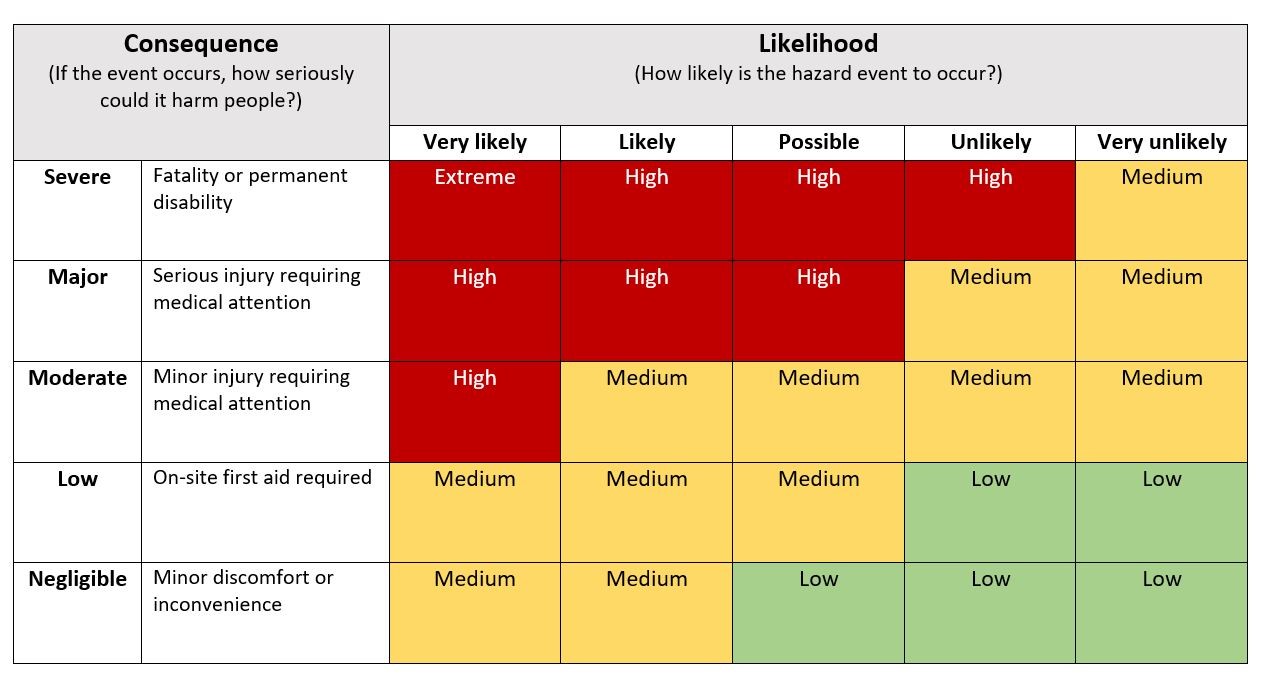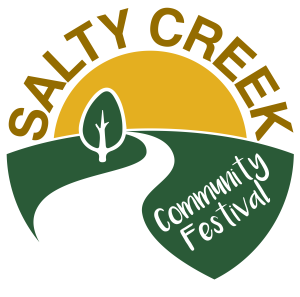Using a risk assessment matrix
In the early stages of festival planning, Sammie and Mia need to develop a risk assessment matrix. Learn more about the steps they follow to make sure disaster doesn’t strike due to poor planning…

![]()
Organising a festival comes with risks that people may not even consider. Each event requires a thorough risk management plan to ensure the safety of attendees and organisers, and the Salty Creek Community Festival is no exception.
One of the festival organisers, Sammie, has helped plan events before but has never been tasked with developing a risk management plan. They’ve asked their sister Mia, the festival’s Engineering and Safety advisor, for help. Sammie and Mia sit down to talk about the plan and how to use a risk assessment matrix to prioritise the potential situations they need to prepare for.
Mia explains the basics to Sammie:
 “A risk management plan is basically a document that outlines the things that could go wrong and how to make sure they don’t.
“A risk management plan is basically a document that outlines the things that could go wrong and how to make sure they don’t.
To do our own, we’ll start with an assessment that looks at the problems that could occur. Then we need to decide how likely they are to happen, and how severe the consequences would be if they did. Finally, we’ll come up with ways to either avoid those risks completely or reduce their impact if they do happen, and then put those plans into action.
So, the main goal of the plan is to make sure everything goes smoothly, and everyone stays safe. Have you heard about the Fyre Festival? It’s a good example of how festivals can go very wrong without proper risk planning.”
CASE STUDY – FYRE FESTIVAL
The Fyre Festival was marketed as a luxury music festival in the Bahamas. It now serves as an example of how not to plan and run an event.
The festival is infamous for its disastrous planning and execution, which has inspired numerous articles and documentaries about the festival’s significant safety risks, lack of planning, and the red flags that were ignored. These included:
- a lack of adequate medical facilities
- unsafe accommodation
- insufficient security measures
- poor crowd control
- environmental hazards
- inadequate food and water provisions
As a result of these shortcomings, the festival was ultimately cancelled, and the organisers faced legal action and public backlash. The Fyre Festival has since become a cautionary tale in the event planning industry, and its failure highlights the importance of risk assessment planning.
Sources:
Baggs, M. (January 2019) ‘Fyre Festival: Inside the world’s biggest festival flop’, BBC News, visited 2 March 2023. https://www.bbc.com/news/newsbeat-46904445
Bluestone, G. (May 2017) ‘Fyre Festival organizers blew all their money months early on models, planes, and yachts’, Vice News, viewed 3 March 2023. https://www.vice.com/en/article/7xwabq/fyre-fest-organizers-blew-all-their-money-months-early-on-models-planes-and-yachts
McKenzie J. (May 2017) ‘Fyre Festival site on ‘lockdown’ by Bahamas government’, ABC News, viewed 2 March 2023. https://abcnews.go.com/Entertainment/fyre-festival-organizers-attendees-refunded-full/story?id=47103941
What is a risk assessment matrix?
“A risk assessment matrix is a tool that helps us assess the likelihood and consequence of a hazard. It can help us visualise the level of risk associated with different hazards and shows us where we need to take action to reduce the risk of things turning out badly.”
What is the difference between a hazard and a risk?
“A hazard is a situation that could potentially harm a person. Risk is the likelihood of negative consequences occurring because of exposure to the hazard. Eliminating the hazard eliminates the risk, but it’s not always possible to completely remove a hazard, and in those cases, we have to manage the risk.”
Hazard: A wooden surface is covered in wet leaves after heavy rain
Risk: Someone will slip over and get hurt (very likely)
How does a risk matrix work?
“There are different types of risk matrices, and they can vary in how complex they are and the categories they use because they’re often made to suit the needs of a specific event or project. So, ours will be made to suit a festival.
A basic matrix usually has a grid that shows the likelihood (probability) of a hazard event occurring and its severity (consequence) if it does. Then, risk events are put into high, medium, or low categories based on where they fall on the grid, which gives them their risk rating.
Look at the matrix we’re going to use for the festival – the consequence is on the y-axis (the left-hand column), and the likelihood is on the x-axis (the top row).”

What does the risk rating mean?
“The risk rating shows us the level of risk associated with each hazard and its potential consequences. It helps us prioritise risk management and figure out where we need to take steps to eliminate, control, or minimise a potential issue. Check out this example of what each risk rating could mean.”
| Extreme and high risk | Medium risk | Low risk |
|---|---|---|
| The level of risk is unacceptable, and steps must be taken to remove the hazard or significantly reduce the risk immediately. The situation must be closely monitored and managed. | The level of risk may be unacceptable. Measures should be taken to reduce the likelihood or consequences of a hazard as soon as possible. The situation should be closely monitored. | The level of risk is acceptable and may not require any additional measures. It is recommended that the situation be monitored. |
What are the steps to working out a risk rating on the matrix?
-
- Identify the hazard, e.g. “a high-magnitude earthquake hitting Salty Creek on the day of the festival.”
- Consider the likelihood of this happening. “Earthquakes are rare in Australia and are usually low magnitude. It’s not impossible, but it’s highly unlikely.”
- Consider the consequences if the hazard event did occur. “Temporary structures and equipment would probably fall, and people could be seriously injured, maybe even killed. The consequences would be major or severe.”
- Find the place on the matrix where the likelihood and consequence intersect to get the risk rating for the hazard. “A high-magnitude earthquake is highly unlikely, and the potential consequences are severe, which gives it a risk rating of Medium, meaning we’ll need to take steps to manage the risk.”
Mia has asked Sammie to have a go using the matrix to assess a hazard. Consider the information below and answer the multiple-choice questions to help Sammie figure out the right risk level for the hazard.
Hazard: A drunk and disorderly attendee.
Now that Mia has explained the risk assessment matrix to Sammie and made sure they’re on the same page, it’s time to begin identifying more potential hazards associated with the festival.
Sammie and Mia consider factors like the weather, the location, the temporary structures, the activities on offer, and the number of attendees.
Based on their analysis, they identify several hazards and consider their associated risks.
Expand the sections below to read about some of the potential hazards Mia and Sammie have identified. Think about how they might be categorised on the risk assessment matrix.
Expandable sections transcript
Where do you think Mia and Sammie will place the hazards mentioned above on the risk matrix? Consider the information given about each one, then select each hazard and drag it (mouse) or move it (keyboard) into the risk rating box you think it belongs in. Don’t forget to check your answers.
Reflect
Mia and Sammie have classified hazards on the risk matrix. The next step in the risk management plan would be to determine the best measures to eliminate, minimise, or manage the risks.
What measures do you think they could take to prevent these problems from occurring?
For example, to manage the risk of heatstroke and dehydration, they will:
- set up plenty of shaded areas for attendees, especially around the stage and eating areas
- provide free water stations
- suggest on the online ticketing portal that attendees prepare for the warm weather by bringing reusable water bottles and wearing hats and sunscreen
- have a first aid tent and trained medical staff on-site to assist attendees.
Now Sammie and Mia have assessed the risks, they have a great starting point for setting up and running the festival and making sure that everyone stays safe and has a great time. Thinking critically about potential issues and using appropriate planning tools, like the risk matrix, will help make the festival, and anything else they plan in the future, a success.
Risk assessment gives you a structured way to look at risk and make informed decisions. This way of thinking can help you make better decisions in your life, studies, and work. Risk assessment is a common practice and requirement in many industries you might want to work in one day, like healthcare, aviation, environmental management, engineering, finance, and IT, just to name a few.

- Knowing how to assess risk can show you’re committed to safety and build trust and credibility with people you work with. It can also give you a head start when applying for roles that require a knowledge of Occupational Health and Safety, like this mechanical engineering role. (5 to 10 minutes)
Learn more on Learning Lab
To see an example of zoo scenarios categorised on a risk matrix, check out the Risk Assessment Matrix page.

